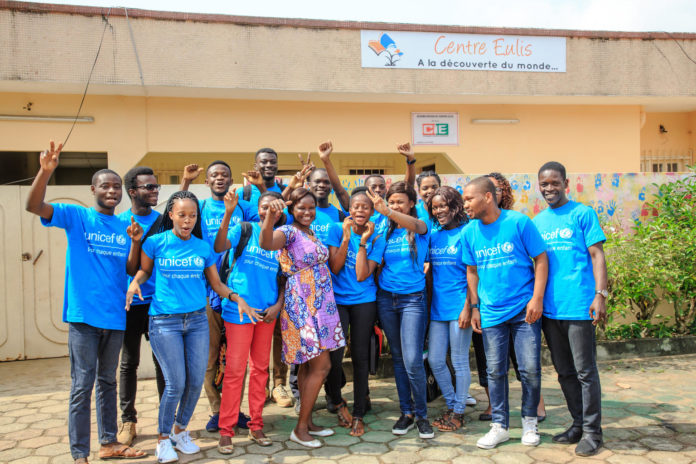
The United Nations Children’s Fund (UNICEF) has launched the Youth Advocacy Guide. Released on July 24, the guide was created by young people from various African countries. The guide “aims to empower young people with skills to bring about positive change in their lives and communities.” It seeks to address the concerns of young with regards to unemployment, child safety, the quality of education, and climate emergencies.
In a press release from the organisation, they say the guide comes at a special time as 2019 is the 30th commemoration of the United Nations (UN) Convention on the Rights of the Child. Unicef says they believe that the guide is “a tool for young people to access what is envisioned in the Convention.”
Maryam Elgoni, the Unicef youth engagement officer told The Daily Vox that it’s “a tool created by African youth for young people who want to create meaningful change in their community.”
The guide is an important tool especially with the growing youth demographic in Africa. The current child population on the continent is currently estimated at 580 million. These figures represent 47% of the entire continent and are four times larger than the child population of Europe.
In 2017, Unicef released a report which said Africa’s child population is projected to increase by 170 million between now and 2030, taking the number of the continent’s under-18s to 750 million. Titled Generation 2030 Africa 2.0: Prioritizing investment in children to reap the demographic dividend, the report spoke about the need to grow investment in young people.
Elgoni said from discussions around the report it was clear that “young people were very knowledgeable about what was going but what they needed was a platform to express their thoughts and opinions.”
This guide aims to be that platform that equips young people on their journey of advocacy. Elgoni says it’s a misconception that young people don’t have a voice. “They need to be allowed to use that voice effectively,” she said.
Creating a guide for youth advocacy is not something that is new. Elgoni admits that many organisations, not just Unicef have guides on advocacy. However, she says the difference with the Unicef guide is that it has been created by young people.
In order to compile the guide, workshops were held run by Unicef and its implementing partner, the South African Institute of International Affairs (SAIIA). During the workshops, the young people involved discussed the challenges they faced and how they envisioned overcoming these challenges.
Four workshops were held across Sub-Saharan Africa in Kenya, Mozambique, Uganda and Cote d’ Ivoire. Elgoni says this allowed them to cover the different languages spoken in the region. Along with SAIIA Unicef hosted workshops with about 10 young people. “The point was to learn from the young people and turn those into teachable moments,” said Elgoni adding that the young people heavily influenced what eventually became the guide.
One of the young people involved in the workshop was Linda Olango, a youth advocate. She was a youth participant at the 2018 Youth Advocacy Guide Workshop, held in Nairobi, Kenya. Olango (22) told The Daily Vox the workshop was helpful because they learned how to work with young people. She says they learned about fact-finding, state of play, working on policy documents, implementation and awareness-raising.
Aside from the workshops, Unicef put out an online call asking young people from the continent to share their experiences around youth advocacy. The almost 200 submissions that were received were written down and have been included in the guide.
Olango who is a student leader in Kenya said she used the guide to help raise awareness about issues facing students. In Kenya, she says students have issues with gender stereotypes as this affects who gets affected as a leader. Other issues include the generational gap between older and younger students. Olango said: “Also most people don’t know what’s affecting them until they gave a name to the issue. This is where fact-finding and the state of the play comes in and the other steps. This is how this guide is helping us to solve problems in our communities.”
The guide is divided into helpful steps which give young people information about how to go about advocating in their community. It starts by first breaking down the different terms like youth participation, advocacy, and policy. The guide then goes more in-depth into finding an issue to advocate for. Once you have found the issue, the guide provides a way forward in terms of developing a plan and finding the right policy.
There is also an interesting section on how to create a social media campaign as well as what to do if you get stuck. The guide is also punctuated with the different stories collected from the online submissions. These are young people who have used advocacy in their communities to solve issues like drug abuse and xenophobia.
For Olango personally, she wants to use the guide to move from proactive advocacy to more meaningful activism. She believes the guide will help her make that shift. “It helps me to be more accurate with how I speak out with my voice,” said Olango.
Olango says that young people are the leaders of the present and have no time to waste. “We have our voices and we need to take advantage of our collective voice and let our voices be heard globally. We can’t wait because there is no time to wait,” said Olango about the importance of youth advocacy.
More information on the guide and additional resources can be found on the Voices of Youth website.
Author’s Note: Linda Olgano was previously referred to as a Unicef youth participant. This has been changed as she is not affiliated with the organisation.
Featured image via UNICEF








